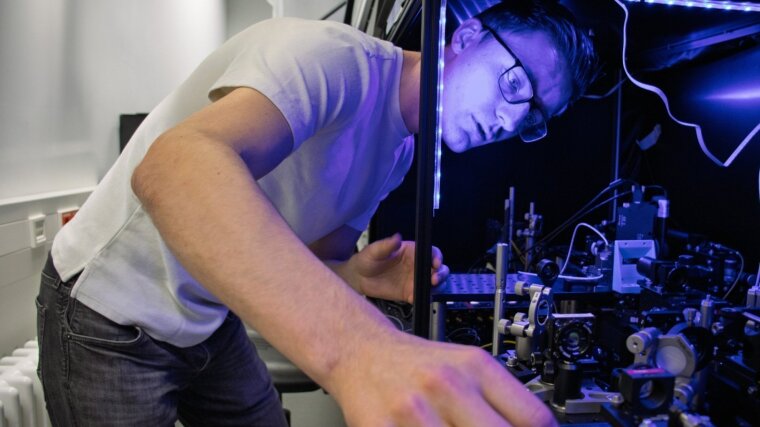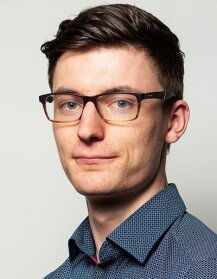
- Light
- Forschung
Published: | By: Ira Winkler
How much - or rather: how little do we actually know about those we work with every day? In this series, we would like to introduce people who carry out research at our institute. They give us an insight into their research, but above all what drives them and how they found their way to us in Jena.
From the series:
KatsuyaTanaka from Japan
Timothy Imogore from Nigeria
With curiosity and perseverance to success
When I meet Maximilian for the interview, I am quickly impressed by his open and communicative nature. His enthusiasm for his work is immediately infectious. Without technical jargon or fancy scientific language, he explains his path and projects - down-to-earth, but with a clear focus. It quickly becomes clear that Maximilian is not only highly competent in his field, but also someone who values dialog and exchange.
Since joining our institute as a research associate in 2019, he has not only been awarded the Physics and Astronomy Faculty's Exam Prize, but also the prestigious EPS-QEOD Travel Grant Student Award and two other awards at conferences. He is also co-author of eleven peer-reviewed publications.
From dual studies to doctorate
His path into science started after school in Rostock with a dual mechanical engineering degree at Siemens in Bavaria, followed by a master’s in photonics in Jena “Laser material processing fascinated me from the very beginning,” he says. During his studies, he worked in the research group of Prof. Stefan Nolte and completed his research lab with Prof. Thomas Pertsch.
A highlight of his education was undoubtedly his time in Australia: Maximilian spent several months at the University of Canberra, where he wrote his master’s thesis under Prof. Neshev. This experience paved the way for his entry into the doctoral program of the Max Planck School of Photonics (MPSP). Since then, he has been conducting research at the Institute of Applied Physics (IAP) in Jena—a place he appreciates for its excellent facilities, strong networking opportunities, and dedicated supervision. With a smile, he adds, “Jena might be a hidden gem alongside Stanford or Cambridge—it has everything to offer and its own unique charm.”
A breakthrough in nano- and quantum optics
Maximilian tells me about his most exciting project, which led to a publication in Nature Communications. Even during his research lab time, he was captivated by the idea of generating entangled photons using specialized materials. “Back then, we focused on monolayer molybdenum disulfide,” he recalls, “but in the end, it turned out to be not efficient enough.” Further research advancements led to the realization that a different manufacturing process was needed, involving multiple overlapping layers of molybdenum disulfide. A collaboration with researchers from Canberra finally made it possible: on just a 10x10x10 micrometer scale, they managed to generate different states of entangled photons. “This is very interesting for applications in communication systems—from mobile phones to space exploration.”
Maximilian’s recipe for success? Patience, perseverance, and openness to collaboration. “You have to keep at it and try new approaches—eventually, everything falls into place.”
A foray into industry: internship at META
In addition to basic research, Maximilian's research work also opened the door to industry. A conference presentation in Switzerland led to a conversation with a META employee, and after several interviews, the opportunity arose: Maximilian spent four months in Seattle. “The work there was very efficient and well -structured. I was quickly integrated into the team and could start working right away,” he says. Of course, he is not allowed to reveal anything about the content of his project, but the experience of conducting research in an industrial setting left a lasting impression. With a sparkle in his eyes, he adds: “And Seattle is a great city for racing cyclists - I tested that extensively.”
Down-to-Earth, Likeable, and Successful
What particularly impresses me about Maximilian is his open view of the world. He is not just a specialist in his field but someone who thinks interdisciplinarily, recognizes opportunities, and actively uses them. “I appreciate the freedom to work independently while still feeling well-supported, as I could always discuss solutions with colleagues like Frank Setzpfandt or Sina Saravi,” he says. The strong teamwork in the Nano & Quantum Optics group has has helped him grow both professionally and personally.
Maximilian's Advice for Young Researchers
Finally, I ask him what advice he would give to others. His response: “Try out different things, look beyond your own field, and build a network. The various stages of my career have given me broad expertise and valuable connections.” He also emphasizes the importance of learning from experienced colleagues: “It saves time and helps avoid mistakes.”
Maximilian is a prime example of how to conduct high-level research while staying grounded. It was an inspiring conversation with a young researcher we will surely hear more about in the future.

Albert-Einstein-Straße 6
07745 Jena Google Maps site planExternal link